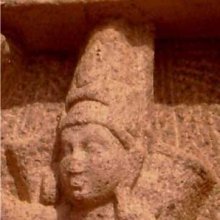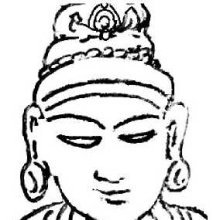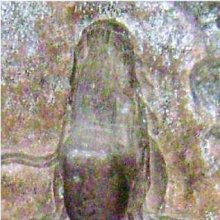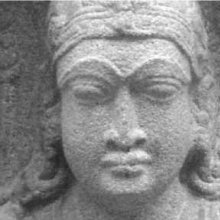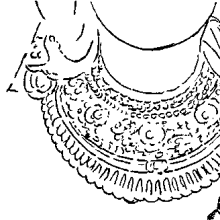Kundala, Kuṇḍala, Kundalā, Kumdala: 41 definitions
Introduction:
Kundala means something in Buddhism, Pali, Hinduism, Sanskrit, Jainism, Prakrit, the history of ancient India, Marathi, Hindi, biology. If you want to know the exact meaning, history, etymology or English translation of this term then check out the descriptions on this page. Add your comment or reference to a book if you want to contribute to this summary article.
Images (photo gallery)
(+75 more images available)
In Hinduism
Purana and Itihasa (epic history)
Source: Google Books: Cultural History from the Vāyu PurānaKuṇḍala (कुण्डल)—One of the Heavenly ornaments according to the Vāyu Purāṇa. Used by the Rākṣasas and by the people of the Kuru country. Bali, Lord of Pātāla, is called Kuṇḍalin.
Source: archive.org: Puranic Encyclopedia1) Kuṇḍala (कुण्डल).—A serpent born in the Kaurava dynasty. It was burnt to death at the serpent yajña of Janamejaya. (Ādi Parva, Chapter 57, Verse 16).
2) Kuṇḍala (कुण्डल).—An urban region in ancient India. (Bhīṣma Parva, Chapter 9, Verse 63).
Source: archive.org: Shiva Purana - English TranslationKuṇḍala (कुण्डल) refers to “ear-rings”, according to the Śivapurāṇa 2.2.21. Accordingly as Brahmā narrated to Nārada:—“[...] When they [viz., Śiva’s Gaṇas (attendants)] went away and He was left alone with Satī, Śiva rejoiced much and sported with her. [...] Sometimes He would be sporting with her ear-rings (kuṇḍala), tying and untying and scrubbing them Himself”.
Source: JatLand: List of Mahabharata people and placesKuṇḍala (कुण्डल) is a name mentioned in the Mahābhārata (cf. I.52.12, I.57, I.89.51) and represents one of the many proper names used for people and places. Note: The Mahābhārata (mentioning Kuṇḍala) is a Sanskrit epic poem consisting of 100,000 ślokas (metrical verses) and is over 2000 years old.
Kuṇḍalā also refers to the name of a River mentioned in the Mahābhārata (cf. VI.10.20).

The Purana (पुराण, purāṇas) refers to Sanskrit literature preserving ancient India’s vast cultural history, including historical legends, religious ceremonies, various arts and sciences. The eighteen mahapuranas total over 400,000 shlokas (metrical couplets) and date to at least several centuries BCE.
Shilpashastra (iconography)
Source: Google Books: Elements of Hindu iconographyKuṇḍala (कुण्डल).—The ear-ornament is known by the general name of Kuṇḍala. At least five different kinds of Kuṇḍalas are known, namely,
- the patrakuṇḍala,
- the nakrakuṇḍala (which is the same as the makarakuṇḍala),
- the śaṅkhapatrakuṇḍala,
- the ratnakuṇḍala
- and the sarpakuṇḍala.
It appears to be probable that in the early periouds of India civilization men and women considered it a beauty to have large ear-ornaments attached to the ear-lobes, which were often specially bored and dilated for the purpose.
Source: Shodhganga: Vaisnava Agamas And Visnu ImagesKuṇḍala (कुण्डल) is another name for Karṇabhūṣaṇa (“ear-ornaments” or “earrings”), as defined in treatises such as the Pāñcarātra, Pādmasaṃhitā and Vaikhānasa-āgamas, extensively dealing with the technical features of temple art, iconography and architecture in Vaishnavism.—A number of ear-ornaments (Karṇabhūṣaṇa) are found in Indian sculptures. Bharata mentions two sets one for male and another for female. [...] Karṇabhūṣaṇa (also know as Karṇakuṇḍala or simply Kuṇḍala) refers to “ear-ornaments” and are usually worn in two different manners: by inserting the earring through a hook into the pierced earlobe and by inserting it directly inside the enlarged earlobe.

Shilpashastra (शिल्पशास्त्र, śilpaśāstra) represents the ancient Indian science (shastra) of creative arts (shilpa) such as sculpture, iconography and painting. Closely related to Vastushastra (architecture), they often share the same literature.
Natyashastra (theatrics and dramaturgy)
Source: Wisdom Library: Nāṭya-śāstraKuṇḍala (कुण्डल) refers to an “ear-ring” and is classified as an ornament (ābharaṇa) for the ears (karṇa) to be worn by males, according to Nāṭyaśāstra chapter 23. It is of the āvedhya type, or “ornaments that are to be fixed by piercing the limbs”. It is to be worn in the lower lobe of the ear. Such ornaments for males should be used in cases of gods and kings.
Kuṇḍala (कुण्डल) also refers to a type of ornament (ābharaṇa) for the ears (karṇa) to be worn by females. Such ornaments for females should be used in cases of human females and celestial beings (gods and goddesses).
Ābharaṇa (‘ornaments’, eg., kuṇḍala) is a category of alaṃkāra, or “decorations”, which in turn is a category of nepathya, or “costumes and make-up”, the perfection of which forms the main concern of the Āhāryābhinaya, or “extraneous representation”, a critical component for a successful dramatic play.

Natyashastra (नाट्यशास्त्र, nāṭyaśāstra) refers to both the ancient Indian tradition (shastra) of performing arts, (natya—theatrics, drama, dance, music), as well as the name of a Sanskrit work dealing with these subjects. It also teaches the rules for composing Dramatic plays (nataka), construction and performance of Theater, and Poetic works (kavya).
Vastushastra (architecture)
Source: OpenEdition books: Architectural terms contained in Ajitāgama and RauravāgamaKuṇḍala (कुण्डल) refers to “motive for crowning (error for kuḍmala ?) §§ 3.30; 4.6.”.—(For paragraphs cf. Les enseignements architecturaux de l'Ajitāgama et du Rauravāgama by Bruno Dagens)

Vastushastra (वास्तुशास्त्र, vāstuśāstra) refers to the ancient Indian science (shastra) of architecture (vastu), dealing with topics such architecture, sculpture, town-building, fort building and various other constructions. Vastu also deals with the philosophy of the architectural relation with the cosmic universe.
Shaktism (Shakta philosophy)
Source: Google Books: Manthanabhairavatantram1) Kuṇḍala (कुण्डल) refers to an “earring”, according to the Kulakaulinīmata.—Accordingly, “[...] Called knowledge, (she is Kuṇḍalinī and) her form is (round like) an earring (kuṇḍala) [i.e., kuṇḍalākārā]. Called action, she is the mother of the letters (varṇamātṛkā). Called will, (her) form is mantra. She is (both) the object of denotation and the denotator. Associated with (both) cause and effect, she emerges from within the pure (energy of the Moon) (vimalānta). She has three natures, she resides on three paths, she is endowed with the three causes and the three energies. She is associated with the letter E. (As) the Supreme Power, she resides within Śiva”.
2) Kuṇḍala (कुण्डल) refers to “earrings” and represents one of the various insignias (i.e., mudrās) worn by a Kāpālika, according to the Āgamaprāmāṇya.—The Kāpālika, as his name—‘Skull Bearer’—implies, carried a skull as part of his penance modelled on that prescribed for having murdered a Brahmin. Along with the skull he was to wear six insignias, namely, a necklace (kuṭhikā), neck ornament (rucaka), earrings (kuṇḍala), crest jewel (śikhāmaṇi), ashes (bhasma) and sacred thread (yajñopavīta). These are described by Yāmunācārya in his Āgamaprāmāṇya and by Rāmānuja who draws from him in his commentary on the Brahmasūtra. The wearing of similar insignia was common practice amongst Buddhist Tantric ascetics who were inspired in their own way by the same model.
Source: Brill: Śaivism and the Tantric Traditions (shaktism)Kuṇḍala (कुण्डल) refers to “earrings”, according to the King Vatsarāja’s Pūjāstuti called the Kāmasiddhistuti (also Vāmakeśvarīstuti), guiding one through the worship of the Goddess Nityā.—Accordingly, “[...] She has braided hair. Her limbs are adorned with bracelets, earrings (kuṇḍala), necklaces, twining laces, girdles, jewels, and anklets. Her clothes resemble Bandhūka flowers. She is full of affection, and the hue of her body is brightened up with saffron and sandal paste.. [...]”.

Shakta (शाक्त, śākta) or Shaktism (śāktism) represents a tradition of Hinduism where the Goddess (Devi) is revered and worshipped. Shakta literature includes a range of scriptures, including various Agamas and Tantras, although its roots may be traced back to the Vedas.
Shaivism (Shaiva philosophy)
Source: Brill: Śaivism and the Tantric Traditions1) Kuṇḍala (कुण्डल) refers to a “(pendant) ear-ornament ”, according to the Guhyasūtra chapter 9.—Accordingly, “[...] [The Lord spoke]:—[...] On one half, there should be a forehead mark; on one half a [forehead] eye. A ring [should be] in one ear; a [pendant] ear-ornament (kuṇḍala) in one ear. He should put a trident in his right hand and a breast on his left side, a girdle on the left half, a bangle on the left arm, a woman’s anklet on the left leg, a man’s anklet on the right leg and a muñja-grass belt. At the hips, he should put a loin-cloth on the right and wear a woman’s garment on the left.”.
2) Kuṇḍala (कुण्डल) refers to “(decorative) rings”, according to the 13th-century Matsyendrasaṃhitā: a Kubjikā-Tripurā oriented Tantric Yoga text of the Ṣaḍanvayaśāmbhava tradition from South India.—Accordingly, “[Visualisation of Parameśvara]:—[...] He is adorned with nice anklets, armlets, rings (kuṇḍala) and bracelets, and he shines with small toe rings, Channahīras, etc., and diadems and a crown. His face is gracious, beautiful, his lips are smeared with betel leaves. His mind is filled with the joy of wine, and his body is supreme bliss [itself]. [...]”.
Source: SOAS University of London: Protective Rites in the Netra TantraKuṇḍala (कुण्डल) refers to “(heavenly) earrings”, according to the Netratantra of Kṣemarāja: a Śaiva text from the 9th century in which Śiva (Bhairava) teaches Pārvatī topics such as metaphysics, cosmology, and soteriology.—Accordingly, [verse 13.1-9, while describing the appearance and worship of Viṣṇu, in the form of Nārāyaṇa]—“He should always think of the four-armed Nārāyaṇa arising. [...] Deva bears divine garments [and] sits atop a divine flower [i.e., a lotus]. [He is] decorated with a gleaming crown of rubies, a small bell, and a net [and] wears heavenly earrings (divya-kuṇḍala-dhartṛ). [...]”.

Shaiva (शैव, śaiva) or Shaivism (śaivism) represents a tradition of Hinduism worshiping Shiva as the supreme being. Closely related to Shaktism, Shaiva literature includes a range of scriptures, including Tantras, while the root of this tradition may be traced back to the ancient Vedas.
Ayurveda (science of life)
Toxicology (Study and Treatment of poison)
Source: Shodhganga: Kasyapa Samhita—Text on Visha ChikitsaKuṇḍala (कुण्डल) is the name of an ingredient used in the treatment of snake-bites such as those caused by the Hemamaṇḍalī-snakes, according to the Kāśyapa Saṃhitā: an ancient Sanskrit text from the Pāñcarātra tradition dealing with both Tantra and Viṣacikitsā—an important topic from Āyurveda which deals with the study of Toxicology (Viṣavidyā or Sarpavidyā).—Accordingly, one of the treatments is mentioned as follows: “[...] A gruel made of Girikarṇikā, Vacā, Viśvā, Kuṇḍala and pepper is to be sprinkled. Honey mixed with Girikarṇikā must be smeared inside the nose.Yellowness of eyes, impaired hearing, anaemia, eye infection, water flowing down from the eyes and bleeding from the pores of the hair on the skin , debility and reduced vision are treated by applying a paste of Dvipatra, dry ginger, pepper, tamarind, root of Śigru and Vacā. [...]”.

Āyurveda (आयुर्वेद, ayurveda) is a branch of Indian science dealing with medicine, herbalism, taxology, anatomy, surgery, alchemy and related topics. Traditional practice of Āyurveda in ancient India dates back to at least the first millenium BC. Literature is commonly written in Sanskrit using various poetic metres.
In Buddhism
Theravada (major branch of Buddhism)
Source: Pali Kanon: Pali Proper Names1. Kundala: Daughter of the king of Devaputta. Once she was a bitch in Kakubandhakandara and a samanera, Tissa, had given her a little food. Later, when Tissa was on his way to the Bodhi tree (in Gaya) she saw him, and, remembering her past existence, invited him to the palace and entertained him. Later she built a vihara for him, where he attained arahantship. Ras.i.103f.
2. An arahant. He came of a brahmin family of Savatthi and entered the Order, but from want of mental balance he could not concentrate his thoughts. Then, one day, while begging for alms, he saw how men conducted water whither they wished by digging channels, how the fletcher fixed the arrow shaft in his lathe surveying it from the corner of his eye, how the chariot makers planed axle and tire and hub. Dwelling on these things, he soon attained arahantship.
In the past he was a park keeper, and gave a coconut to the Buddha Vipassi, which the Buddha accepted while travelling through the air (ThagA.i.71f). Perhaps he is to be identified with Nalikeradayaka Thera of the Apadana (ii.447f). The same Apadana verses, however, are also ascribed to Khitaka Thera (ThagA.i.315f). The verse attributed to Kundala in the Theragatha (Thag.19) occurs twice in the Dhammapada, and is in the Dhammapada Commentary mentioned as having been preached once in reference to Pandita Samanera (DhA.ii.147), and once in reference to Sukha Samanera (DhA.iii.99).
Theravāda is a major branch of Buddhism having the the Pali canon (tipitaka) as their canonical literature, which includes the vinaya-pitaka (monastic rules), the sutta-pitaka (Buddhist sermons) and the abhidhamma-pitaka (philosophy and psychology).
Tibetan Buddhism (Vajrayana or tantric Buddhism)
Source: Google Books: VajrayoginiKuṇḍala (कुण्डल) refers to “earrings” and represents one of the five mudrās (tantric ornaments) of Vajravārāhī, according to the 12th-century Abhisamayamañjarī. These mudrās are depicted upon Vajravārāhī’s body and are all made of human bone. They are made to represent the five signs of kāpālika observance.
Source: Google Books: Manthanabhairavatantram (tantric buddhism)Kuṇḍala (कुण्डल) refers to “earrings”, representing one of the “five insignias” (Pañcamudrā) worn by the initiate who observed the outer form of the Vow of Knowledge, according to the Buddhist Hevajratantra.—Accordingly, “He receives the five symbolic adornments, crown [cakrī], earrings [kuṇḍala], necklace [kaṇṭhī], bracelets [rucaka], and girdle, as signs of his success. These he wears on those set occasions... when perfected Yogins and Yoginīs come together, to consume flesh and wine, to sing and dance, and realised their consummation of bliss. He is free from all conventions and wanders as he pleases, knowing no distinction between friend and foe, clean or unclean, good or evil”.
Source: academia.edu: The Structure and Meanings of the Heruka MaṇḍalaKuṇḍala (कुण्डल) refers to one of the eight trees (vṛkṣa) of the Jñānacakra, according to the 10th century Ḍākārṇava chapter 15. Accordingly, the jñānacakra refers to one of the three divisions of the saṃbhoga-puṭa (‘enjoyment layer’), situated in the Herukamaṇḍala. Kuṇḍala is associated with the charnel ground (śmaśāna) named Hāhārava and with the direction-guardian (dikpāla) named Ravitana.
Source: OSU Press: Cakrasamvara SamadhiKuṇḍala (कुण्डल) refers to “(possesing) ear-rings” which is used to describe Cakrasaṃvara, according to the Saṃvaramaṇḍala of Abhayākaragupta’s Niṣpannayogāvalī, p. 45 and n. 145; (Cf. Cakrasaṃvaratantra, Gray, David B., 2007).—Accordingly, [while describing the iconography of Cakrasaṃvara]: “In the Saṃvara Maṇḍala atop Mount Sumera within a vajra-canopy there is a variegated lotus, on top of that a palace, in the middle of which is the Blessed Lord, standing in ālīḍhāsana, "archer's pose", [...] possessing a naraśiromālā-śatārdha, "garland of fifty (fresh) human heads" around the neck, the ṣaṇmudrā, "six insignia", bone ornaments, which are the kaṇṭhikā, "necklace", rucaka, "bracelets", kuṇḍala, "ear-rings", mekhalā, "girdle", śiromaṇi, "crest jewel", and bhasmitiḥ, "covered in ashes", a jaṭā-makuṭa, "crest of dreadlocks", kapālamālā, "crown of (five) skulls", topped by an ardhacandra, "crescent moon", and viśvavajra, "world vajra" or "double vajra", a vikṛitānana, "fierce face", and daṃṣṭrotkaṭa, "horrible gigantic fangs".

Tibetan Buddhism includes schools such as Nyingma, Kadampa, Kagyu and Gelug. Their primary canon of literature is divided in two broad categories: The Kangyur, which consists of Buddha’s words, and the Tengyur, which includes commentaries from various sources. Esotericism and tantra techniques (vajrayāna) are collected indepently.
In Jainism
General definition (in Jainism)
Source: Wisdom Library: JainismKuṇḍala (कुण्डल) is the shorter name of Kuṇḍaladvīpa, one of the continents (dvīpa) of the middle-world (madhyaloka) which is encircled by the ocean named Kuṇḍalasamudra (or simply Kuṇḍala), according to Jain cosmology. The middle-world contains innumerable concentric dvīpas and, as opposed to the upper-world (adhaloka) and the lower-world (ūrdhvaloka), is the only world where humans can be born.
Kuṇḍala is recorded in ancient Jaina canonical texts dealing with cosmology and geography of the universe. Examples of such texts are the Saṃgrahaṇīratna in the Śvetāmbara tradition or the Tiloyapannatti and the Trilokasāra in the Digambara tradition.
Source: archive.org: Een Kritische Studie Van Svayambhūdeva’s PaümacariuKuṇḍala (कुण्डल) participated in the war between Rāma and Rāvaṇa, on the side of the latter, as mentioned in Svayambhūdeva’s Paumacariu (Padmacarita, Paumacariya or Rāmāyaṇapurāṇa) chapter 57ff. Svayambhū or Svayambhūdeva (8th or 9th century) was a Jain householder who probably lived in Karnataka. His work recounts the popular Rāma story as known from the older work Rāmāyaṇa (written by Vālmīki). Various chapters [mentioning Kuṇḍala] are dedicated to the humongous battle whose armies (known as akṣauhiṇīs) consisted of millions of soldiers, horses and elephants, etc.
Source: archive.org: The Jaina IconographyKuṇḍalā (कुण्डला) is the name of a Yoginī mentioned in various Jaina manuscripts, often being part of a list of sixty-four such deities. How the cult of the Tantrik Yoginīs originated among the vegetarian Jainas is unknown. The Yoginīs (viz., Kuṇḍalā) are known as attendants on Śiva or Pārvatī. But in the case of Jainism, we may suppose, as seen before that they are subordinates to Kṣetrapāla, the chief of the Bhairavas.

Jainism is an Indian religion of Dharma whose doctrine revolves around harmlessness (ahimsa) towards every living being. The two major branches (Digambara and Svetambara) of Jainism stimulate self-control (or, shramana, ‘self-reliance’) and spiritual development through a path of peace for the soul to progess to the ultimate goal.
India history and geography
Source: What is India: Inscriptions of the VākāṭakasKuṇḍala (कुण्डल) refers to “jewelled ear-ornaments”, which was worn by kings during the reign of the Vākāṭakas (mid-3rd century CE).—Ajaṇṭā paintings give us a clear idea of the costume and jewellery worn by men and women in Vidarbha in the age of the Vākāṭakas. [...] Men and women were very fond of jewellery in the Vākāṭaka age. Merchants, middle class people and servants generally appear without jewellery on their person, but kings, princes, high officers, queens and wives of rich people as also their maids are represented with a variety of ornaments. [...] Kings used to wear a high jewelled diadem. They also put on jewelled ear-ornaments (kuṇḍalas) and necklaces of pearls or gems. Their arms were adorned with jewelled armlets (aṅgadas), with strings of pearls hanging from them.

The history of India traces the identification of countries, villages, towns and other regions of India, as well as mythology, zoology, royal dynasties, rulers, tribes, local festivities and traditions and regional languages. Ancient India enjoyed religious freedom and encourages the path of Dharma, a concept common to Buddhism, Hinduism, and Jainism.
Biology (plants and animals)
Source: Wisdom Library: Local Names of Plants and DrugsKundala [कुण्डल] in the Sanskrit language is the name of a plant identified with Tinospora cordifolia from the Menispermaceae (Moonseed) family. For the possible medicinal usage of kundala, you can check this page for potential sources and references, although be aware that any some or none of the side-effects may not be mentioned here, wether they be harmful or beneficial to health.

This sections includes definitions from the five kingdoms of living things: Animals, Plants, Fungi, Protists and Monera. It will include both the official binomial nomenclature (scientific names usually in Latin) as well as regional spellings and variants.
Languages of India and abroad
Pali-English dictionary
Source: BuddhaSasana: Concise Pali-English Dictionarykuṇḍala : (nt.) an earring; a curl.
Source: Sutta: The Pali Text Society's Pali-English DictionaryKuṇḍala, (cp. kuṇḍa, orig. bending, i.e. winding) a ring esp. earring A. I, 254=III, 16; J. IV, 358 (su° with beautiful earrings); DhA. I, 25. Frequent as maṇi°, a jewelled earring Vin. II, 156; S. I, 77; M. I, 366; Pv. II, 950; sīha° or sīhamukha° an earring with a jewel called “lion’s mouth” J. V, 205 (=kuñcita), 438. In sāgara° it means the ocean belt Miln. 220=J. III, 32 (where expl. as sāgaramajjhe dīpavasena ṭhitattā tassa kuṇḍalabhūtaṃ). Cp. also rajju° a rope as belt VvA. 212.—kuṇḍalavatta turning, twisting round D. II, 18 (of the hair of a Mahāpurisa). (Page 220)

Pali is the language of the Tipiṭaka, which is the sacred canon of Theravāda Buddhism and contains much of the Buddha’s speech. Closeley related to Sanskrit, both languages are used interchangeably between religions.
Marathi-English dictionary
Source: DDSA: The Molesworth Marathi and English Dictionarykuṇḍala (कुंडल).—n (S) An ear-ring. 2 A ring or circle (of metal &c.)
--- OR ---
kuṇḍalā (कुंडला).—m (kuṇḍala S) A bowl of stone or earth (for grinding snuff &c.)
Source: DDSA: The Aryabhusan school dictionary, Marathi-Englishkuṇḍalā (कुंडला).—m A bowl of stone or earth.
Marathi is an Indo-European language having over 70 million native speakers people in (predominantly) Maharashtra India. Marathi, like many other Indo-Aryan languages, evolved from early forms of Prakrit, which itself is a subset of Sanskrit, one of the most ancient languages of the world.
Sanskrit dictionary
Source: DDSA: The practical Sanskrit-English dictionaryKuṇḍala (कुण्डल).—[kuṇḍa-matvarthe la]
1) An ear-ring; श्रोत्रं श्रुतेनैव न कुण्डलेन (śrotraṃ śrutenaiva na kuṇḍalena) Bhartṛhari 2.71; Ch. P.11; Ṛtusaṃhāra 2.2,3.19; R.11.15.
2) A bracelet; Śiśupālavadha 6.27.
3) The coil of a rope.
4) A fetter, tie, collar.
Derivable forms: kuṇḍalaḥ (कुण्डलः), kuṇḍalam (कुण्डलम्).
Source: Cologne Digital Sanskrit Dictionaries: Edgerton Buddhist Hybrid Sanskrit DictionaryKuṇḍala (कुण्डल).—(1) (nt.) coil (of rope): Jātakamālā 23.11 anyatra rajju-kuṇḍalād dātrāc caikasmāt; see next (1); (2) in Lalitavistara 276.22 nīla-mṛdu-kuṇḍala-jāta-pradakṣiṇa-nandyā- [Page186-a+ 71] varta-kācilindika-sukhasaṃsparśaiś ca tṛṇair, the word kuṇḍala (vv.ll. kuntala, kuṇṭaka) is obscure; it is omitted from the [compound] in Foucaux's Tibetan; a late Sanskrit Lex. records the meaning thick for kuṇṭaka; this meaning would fit here but there is no other support for a word kuṇṭaka. On the other hand, perhaps kuṇḍala-jāta-means simply curling (of blades of grass, tṛṇa); compare kuṇḍalaka (2) -jāta, of hair; Foucaux's Note p. 167, bottom, actually cites this form of the [compound] as the reading of one ms., but adds that Tibetan indicates a reading kuśa-jāta (of this his Tibetan text and its translation(s) contain no trace); curling seems to me a curious epithet to be applied to grass; (3) (compare Sanskrit Lex. id. = pāśa), a ring as a kind of fetter: Gaṇḍavyūha 353.12, see s.v. kaṭaka; (4) m., name of a form of a mendicant, created magically by Māra to obstruct Buddha: Mahāvastu i.270.13.
--- OR ---
Kuṇḍalā (कुण्डला).—name of a yakṣiṇī: Mahāvastu i.253.1.
Source: Cologne Digital Sanskrit Dictionaries: Shabda-Sagara Sanskrit-English DictionaryKuṇḍala (कुण्डल).—n.
(-laṃ) 1. An earring. 2. A bracelet. 3. A fetter, a tie, a collar. f. (-lī) 1. Mountain ebony: see kāñcana. 2. Guruchi, a plant, (Menispermum glabrum.) see guḍūcī. 3. Cowach. E. kuḍi to preserve, kalac aff.
Source: Cologne Digital Sanskrit Dictionaries: Benfey Sanskrit-English DictionaryKuṇḍala (कुण्डल).—. I. m. and n. 1. A ring, [Bhāgavata-Purāṇa, (ed. Burnouf.)] 5, 23, 3. 2. An ear-ring, [Bhartṛhari, (ed. Bohlen.)] 2, 63. Ii. m. The name of a Nāga, Mahābhārata 1, 2154. Iii. f. lā, A proper name, Mārk. P. 21, 34.
— When the latter part of a comp. adj., the f. is lā, e. g. śaila-, adj., f. lā, Surrounded by mountains, Mahābhārata 3, 10943. sa-, adj. With earrings.
Source: Cologne Digital Sanskrit Dictionaries: Cappeller Sanskrit-English DictionaryKuṇḍala (कुण्डल).—[neuter] ring, [especially] ear-ring.
Source: Cologne Digital Sanskrit Dictionaries: Monier-Williams Sanskrit-English Dictionary1) Kuṇḍala (कुण्डल):—n. (ifc. f(ā). ; [gana] sidhmādi and ardharcādi) a ring, ear-ring, [Āśvalāyana-gṛhya-sūtra; Lāṭyāyana; Manu-smṛti] etc.
2) a bracelet, [Śiśupāla-vadha vi, 27]
3) a fetter, tie, [cf. Lexicographers, esp. such as amarasiṃha, halāyudha, hemacandra, etc.]
4) the coil of a rope, [cf. Lexicographers, esp. such as amarasiṃha, halāyudha, hemacandra, etc.]
5) a particular disease of the bladder, [Caraka]
6) a rope, [Jātakamālā]
7) m. (in music) a kind of measure
8) Name of a Nāga, [Mahābhārata i, 2154]
9) m. [plural] Name of a people ([varia lectio] kuṇṭhaka), [Mahābhārata vi]
10) Kuṇḍalā (कुण्डला):—[from kuṇḍala] f. Name of a woman, [Mārkaṇḍeya-purāṇa]
Source: Cologne Digital Sanskrit Dictionaries: Yates Sanskrit-English DictionaryKuṇḍala (कुण्डल):—[(laṃ-lā)] 1. n. An ear-ring, bracelet, fetter. f. Mountain ebony.
Source: DDSA: Paia-sadda-mahannavo; a comprehensive Prakrit Hindi dictionary (S)Kuṇḍala (कुण्डल) in the Sanskrit language is related to the Prakrit words: Kuṃḍala, Kuṃḍalā.
[Sanskrit to German]
Sanskrit, also spelled संस्कृतम् (saṃskṛtam), is an ancient language of India commonly seen as the grandmother of the Indo-European language family (even English!). Closely allied with Prakrit and Pali, Sanskrit is more exhaustive in both grammar and terms and has the most extensive collection of literature in the world, greatly surpassing its sister-languages Greek and Latin.
Hindi dictionary
Source: DDSA: A practical Hindi-English dictionaryKuṃḍala (कुंडल) [Also spelled kundal]:—(nm) a large-sized ear-ring; ~[lākāra] circular, ring-like.
...
Prakrit-English dictionary
Source: DDSA: Paia-sadda-mahannavo; a comprehensive Prakrit Hindi dictionary1) Kuṃḍala (कुंडल) in the Prakrit language is related to the Sanskrit word: Kuṇḍala.
2) Kuṃḍala (कुंडल) also relates to the Sanskrit word: Kuṇḍala.
3) Kuṃḍalā (कुंडला) also relates to the Sanskrit word: Kuṇḍalā.
Prakrit is an ancient language closely associated with both Pali and Sanskrit. Jain literature is often composed in this language or sub-dialects, such as the Agamas and their commentaries which are written in Ardhamagadhi and Maharashtri Prakrit. The earliest extant texts can be dated to as early as the 4th century BCE although core portions might be older.
Kannada-English dictionary
Source: Alar: Kannada-English corpusKuṃḍala (ಕುಂಡಲ):—
1) [noun] a ring or other small ornament for the lobe of the ear, either passed through a hole pierced in the lobe or fastened with a screw or clip; an ear-ring.
2) [noun] a badge of honour worn by scholars.
3) [noun] a loop formed in a rope, cord, etc. by means of a slipknot so that the loop tightens as the rope is pulled; a noose.
4) [noun] either or both of the curved lines, ( ), used to mark off parenthetical words, etc. or to enclose mathematical or logical symbols that are to be treated as a single term; a bracket; a parenthesis.
5) [noun] a plane figure bounded by a single curved line, every point of which is equally distant from the point at the centre of the figure; a circle.
6) [noun] a circular band, as of metal, plastic, etc., used for some special purpose; a ring.
--- OR ---
Kuṃḍaḷa (ಕುಂಡಳ):—[noun] = ಕುಂಡಲ [kumdala].
--- OR ---
Kuṃdaḷa (ಕುಂದಳ):—[noun] = ಕುಂದಣ [kumdana].
Kannada is a Dravidian language (as opposed to the Indo-European language family) mainly spoken in the southwestern region of India.
Nepali dictionary
Source: unoes: Nepali-English DictionaryKuṇḍala (कुण्डल):—n. 1. an ear-ring; 2. ring; hoop; halo;
Nepali is the primary language of the Nepalese people counting almost 20 million native speakers. The country of Nepal is situated in the Himalaya mountain range to the north of India.
See also (Relevant definitions)
Starts with (+30): Kumdaladikshita, Kumdalapamdita, Kumdalavadi, Kumdalayuga, Kundalabhushita, Kundalaci, Kundaladarshana, Kundaladhara, Kundaladharana, Kundaladharin, Kundaladhartri, Kundaladvipa, Kundalaka, Kundalakara, Kundalakesa, Kundalakesittheri Vatthu, Kundalakriti, Kundalakshana, Kundalakshyavivriti, Kundalamandita.
Ends with (+32): Akundala, Amdajadhipakumdala, Calakundala, Carukundala, Chalakundala, Chitrakundala, Citrakundala, Divyakundala, Dolayitashravanakundala, Ekakundala, Hemakundala, Kaadu-karna-kundala, Kadu-karna-kundala, Kadukarnakumdala, Kanakakundala, Kapalakundala, Karna kundala, Karnakundala, Kurmakundala, Lolakundala.
Full-text (+173): Kundali, Kundaladharana, Ekakundala, Kundalita, Kundalara, Kundalibhuta, Kundaladharin, Mrishtakundala, Makarakundala, Kundalikrita, Kundalana, Kundalakara, Kunthaka, Sarpakundala, Kula, Ratnakundala, Nrtya kundala, Karna kundala, Kumdalu, Kanakakundala.
Relevant text
Search found 62 books and stories containing Kundala, Kuṇḍala, Kundalā, Kumdala, Kuṇḍalā, Kundaḷa, Kuṃdaḷa, Kuṇḍaḷa, Kuṃḍaḷa, Kuṃḍalā, Kuṃḍala; (plurals include: Kundalas, Kuṇḍalas, Kundalās, Kumdalas, Kuṇḍalās, Kundaḷas, Kuṃdaḷas, Kuṇḍaḷas, Kuṃḍaḷas, Kuṃḍalās, Kuṃḍalas). You can also click to the full overview containing English textual excerpts. Below are direct links for the most relevant articles:
Pallava period (Social and Cultural History) (by S. Krishnamurthy)
Ear Ornaments (Karnabhushana) < [Chapter 4 - Material Culture of the People]
Conclusion (Material Culture) < [Chapter 5 - Conclusion]
Origin of Sculptural Art (c): Pallava period < [Chapter 2 - Origin of Sculptural Art—Its Development and Scheme]
Garga Samhita (English) (by Danavir Goswami)
Verse 5.24.63 < [Chapter 24 - The Killing of the Kola Demon]
Verse 4.1.2 < [Chapter 1 - The Story of the Personified Vedas]
Verse 4.13.13 < [Chapter 13 - The Story of the Demigoddesses]
Bhajana-Rahasya (by Srila Bhaktivinoda Thakura Mahasaya)
Text 8 < [Chapter 5 - Pañcama-yāma-sādhana (Aparāhna-kālīya-bhajana–kṛṣṇa-āsakti)]
Text 18 < [Chapter 6 - Ṣaṣṭha-yāma-sādhana (Sāyaṃ-kālīya-bhajana–bhāva)]
Early Chola Temples (by S. R. Balasubrahmanyam)
Bronze, group 3: Age of Parantaka I (a.d. 907 - 950) < [Chapter XI - Sculpture]
Bronze, group 2: Age of Aditya I (a.d. 871-907) < [Chapter XI - Sculpture]
A History of Indian Philosophy Volume 3 (by Surendranath Dasgupta)
Part 5 - Criticism of the views of Rāmānuja and Bhāskara < [Chapter XXI - The Nimbārka School of Philosophy]
Part 2 - A General Idea of Nimbārka’s Philosophy < [Chapter XXI - The Nimbārka School of Philosophy]
Related products
